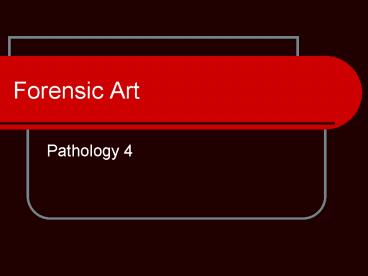Forensic Art - PowerPoint PPT Presentation
1 / 14
Title: Forensic Art
1
Forensic Art
- Pathology 4
2
Forensic Approximation
- Forensic approximation is a process that attempts
to recreate unidentified persons likeness - Uses several sciences to make accurate
predictions - Anthropology
- Osteology
- Anatomy
- There is also an element of art
3
Forensic Approximation
- Used for non-criminal applications as well as law
- Legally controversial
- Fails the Daubert Standard (1993)
- Expert testimony
- No two experts would derive the exact same
conclusion - Not admissable as evidence in court
- Can be used as an investigative aid only
4
Forensic Approximation
Forensic approximation of the Spirit Cave Man,
one of only a few complete skeletons found in the
United States over 8,000 years old.
5
Forensic Approximation
- History
- First used in 1883 for archeological digs
- First study of facial tissue thickness was
completed - First used in forensics in 1962
6
Identification
- Two types of identification
- Circumstantial
- Individual fits the general profile for a set of
skeletal remains - Positive
- Individual has unique set of characteristics
shared with skeletal remains - Facial reconstructions are the most common
7
Facial Reconstructions
- Generally based on skull, photographs, x-rays
- Usually require both an anthropologist and an
artist - 3 Types
- 2D Reconstruction
- Hand drawn or computer generated portraits
- FACE and CARES software
- 3D Reconstruction
- Includes sculptures, 3D computer imagery
8
3D Facial Reconstruction
9
Facial Reconstructions
- Superimposition
- Only useful if there is some idea of the remains
identity - Places a photograph over x-ray of skull and looks
for similarities
10
Superimposition
11
Facial Reconstructions
- Thorough exam of skull needed
- Muscle attachments
- Damage, wounds
- Shape of skull, eyes, nasal openings
- Skull cleaned and damaged areas repaired with wax
- Mandible reattached
- Eyes inserted
- Pegs used to identify typical tissue thickness
- Nose is largely an educated guess
12
Soft Tissue Reconstruction
13
Limitations of Facial Reconstructions
- Insufficient data
- Face is extremely complicated
- 10 muscle groups in human face
- Subtle differences between races, sex, body
builds - Cartilage does not remain
- No standardization
- Different techniques and approaches
- Subjectivity
- Wrinkles, birthmarks, skin folds
14
Famous Reconstructions
In 2005, forensic anthropologists and artists
worked together to create the face of the
legendary King Tut.

